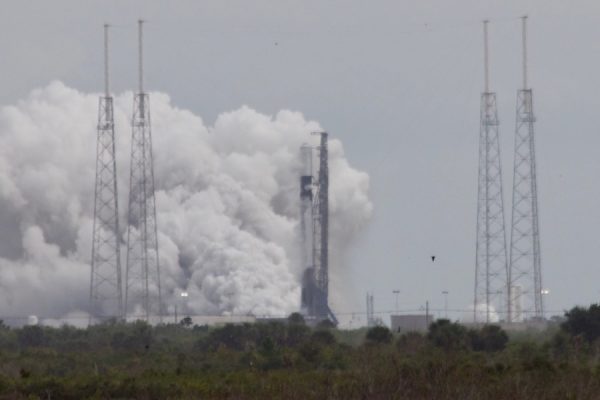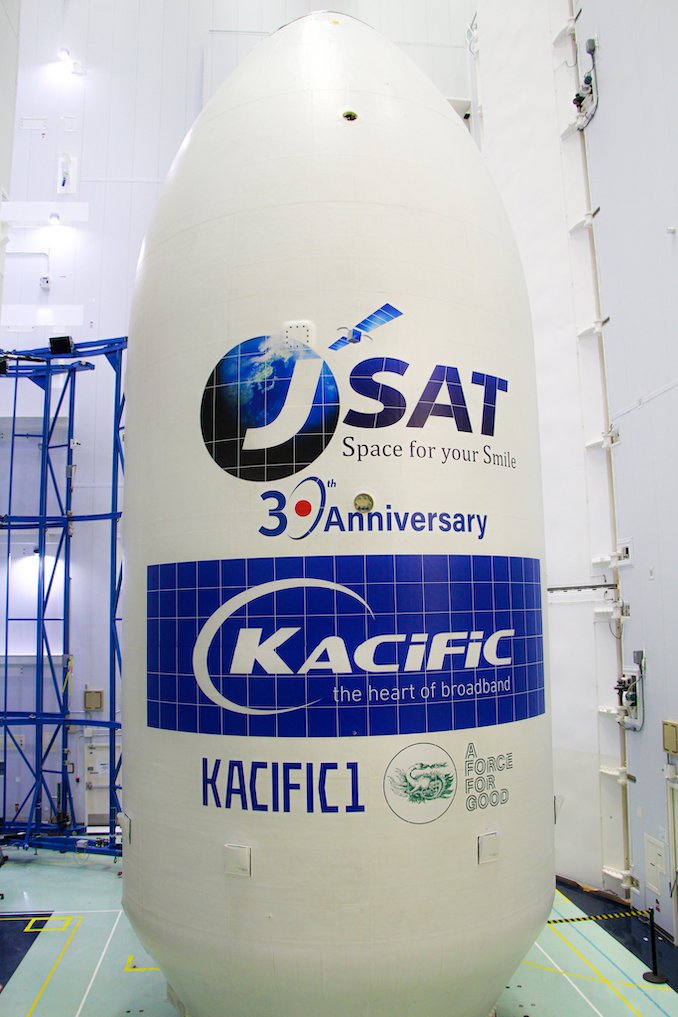SpaceX performs hold-down firing for heavyweight satellite launch Monday – Spaceflight Now

A test-firing of a twice-flown Falcon 9 booster Friday at Cape Canaveral paved the way for SpaceX’s next launch, scheduled for Monday night with a heavyweight Boeing-built communications satellite to beam broadband signals to Japan and the Pacific islands.
SpaceX is readying the Falcon 9 rocket for liftoff with the JCSAT 18/Kacific commercial communications satellite Monday at 7:10 p.m. EST (0010 GMT Tuesday). The launch window extends for 88 minutes.
There is a 90 percent chance of favorable weather during Monday night’s launch window, according to U.S. Air Force meteorologists.
But first, SpaceX performed a hold-down test-firing of the Falcon 9’s first stage Merlin engines Friday. The test-firing is a customary pre-launch checkout before every SpaceX mission, providing a test of launch vehicle systems and a rehearsal for the company’s launch team.
The Falcon 9 was raised vertical at pad 40 without its satellite payload or fairing Friday in preparation for the static fire test. SpaceX loaded super-chilled, densified kerosene and liquid oxygen propellants into the two-stage Falcon 9 rocket, and the countdown proceeded through through the final steps before launch, including retraction of the strongback structure into position for liftoff and pressurization of the rocket’s propellant tanks.
Spaceflight Now members can watch a video replay of the test firing. Our live coverage is made possible by the support of our members. Please support our coverage by becoming a member today.
The nine Merlin 1D engines at the bottom of the Falcon 9’s first stage ignited for several seconds at 1:20 p.m. EST (1820 GMT) Friday, throttling up to full power to generate some 1.7 million pounds of thrust as hold-down restraints keep the rocket firmly on the ground.
SpaceX engineers will perform a data review after the static fire as technicians at Cape Canaveral roll the rocket back to the hangar and prepare to mate it with the JCSAT 18/Kacific 1 communications satellite inside a climate-controller hangar.
The Falcon 9 rocket slated to launch the JCSAT 18/Kacific 1 spacecraft is a veteran of two previous missions. It first launched in May on a space station cargo mission, then landed on SpaceX’s drone ship in the Atlantic Ocean. On its second flight, the rocket again powered a Dragon supply ship toward the space station, and returned to Cape Canaveral for an onshore landing.
SpaceX is expected to recover the first stage again after Monday’s launch aboard a drone ship in the Atlantic east of Florida’s Space Coast.
The 15,335-pound (6,956-kilogram) JCSAT 18/Kacific 1 spacecraft will launch into an elliptical transfer orbit, then use its on-board liquid-fueled engine to maneuver into a circular geostationary orbit more than 22,000 miles (nearly 36,000 kilometers) over the equator.

Based on Boeing’s 702MP satellite design, the communications station is a shared spacecraft between Sky Perfect JSAT Corp. of Japan and Kacific, a startup telecom company headquartered in Singapore.
JSAT will use the satellite’s Ku-band capacity to provide communication services over Japan and the broader Asia-Pacific region, with a coverage range extending from Indonesia and Southeast Asia to coastal China and Eastern Russia.
Kacific’s mission will utilize the satellite’s Ka-band payload, which includes 56 spot beams delivering up to 60 gigabits per second of data throughput capacity, the company said.
The new satellite will “provide the most powerful signal level ever achieved in a commercial satellite in the (Asia-Pacific) region,” Kacific said in a statement. Founded in 2013, Kacific says the JCSAT 18/Kacific 1 spacecraft will stream broadband to 25 nations in Southeast Asia and in the Pacific islands, where dispersed populations and rugged terrain pose roadblocks for building terrestrial Internet links.
Kacific says education, health care and emergency response services will benefit from the company’s satellite broadband network.
The mission set for launch Monday will mark SpaceX’s 13th flight of the year, and the second in 11 days from the same launch pad at Cape Canaveral Air Force Station. If the Falcon 9 takes off Monday night, it would mark the fastest turnaround between SpaceX missions from the same launch pad.
Email the author.
Follow Stephen Clark on Twitter: @StephenClark1.






